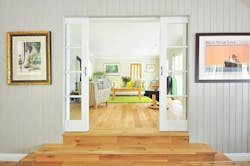Even before COVID-19 caused consternation about indoor ventilation, builders and buyers alike were starting to look at “healthy homes,” which promise better indoor air quality, humidity control, and easier-to-clean surfaces compared to conventional or resale homes.
It’s an appealing set of features to buyers, particularly for those concerned about pollen, mold, dust, and other allergens. But it’s also a relatively new offering in many markets, leaving builders with the dual challenges of building a healthy home and marketing it effectively to customers.
In December, UTOPIA discussed these issues and more during our Trends in Indoor Air Quality (IAQ) for Healthy Homes webinar, featuring Phillippe Lord, CEO of public builder Meritage Homes; Jenni Lantz, director of John Burns Real Estate Consulting’s New Home Trends Institute; and Russell Pope, senior manager of Panasonic Ventilation and IAQ Solutions. David Barista, UTOPIA’s content director, moderated the discussion.
4 Tips on Building and Selling Healthy Homes
Here are four takeaways from their talk:
1. Energy efficiency is a great place to start your healthy homes initiative
“There’s a lot of synergy between the energy efficiency approach and the healthy home,” said Lord, who says Meritage’s move to spray foam insulation a decade ago was a pivotal decision for the public builder. “That was the big move, and we basically had to redesign our homes from the foundation up to support spray foam insulation. We had to redesign the HVAC systems. We had to resign our air filtration systems,” he says. “It really set the stage for all the evolution and renovation we’ve done for the past 10 years.”
2. Building a healthy home doesn’t have to raise your construction costs
“We are pretty much cost-neutral,” says Lord, whose company in November announced it would provide MERV-13 filtration in all its homes. “Yes, certain products cost more than others, but in the redesign of the homes and the science of how we are building our homes today, we have been able to neutralize quite a bit of the costs.”
3. Indoor air quality matters to consumers
Unlike many new-home certifications, the EPA’s Indoor airPLUS designation “is actually something of value to consumers,” said Lantz, who urges builders to use indoor air quality to differentiate their healthy homes from the competition of existing resale homes. Some buyers may be looking at air quality because they or someone in their family have allergies; an estimated 35 million Americans have “upper respiratory reactions to airborne allergens,” according to Pope’s presentation.
4. Invest in buyer education on healthy homes
While people are interested in healthy homes, they may not really understand how a healthy home functions. “Consumers just don’t know how much ventilation they need or when to ventilate,” says Pope of Panasonic, whose Cosmos system has customizable presets for parties or other gatherings. As a result, consumers typically rank energy efficiency as a higher priority, according to Lantz, “because they can see an immediate result” through lower utility bills. She recommends explaining to buyers why living in a healthy home can be beneficial in an easy to understand and memorable way.
Want to learn more about building and selling healthy homes? Watch UTOPIA's Trends in Indoor Air Quality (IAQ) for Healthy Homes webinar on demand.
RELATED: The Healthy Home Trend: Consumers Pay More for Wellness and Comfort
